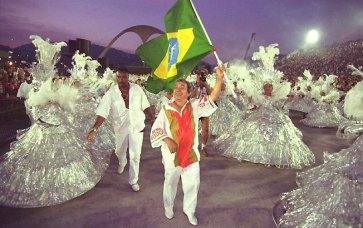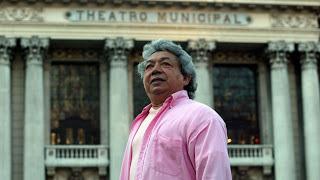
Joaozinho Trinta (correiodeuberlandia.com.br)
Welcome to Munchkin Land
Where the most recent re-working of Orfeu really came into its own — and where the earlier foreign-made film product left much to be desired — was in its authentic depiction of Rio de Janeiro at Carnival time.
In his striving to overcome Black Orpheus’ most glaring cinematic deficiency, i.e., its failure to “communicate the real organizational complexities and extended preparations of a samba school [on the march]… Diegues, aware of the problems with setting in Camus’ original film, made a conscious effort to bring his film production and the participating [Viradouro] samba school together ‘so that everything would happen where the story really exists’” — quite literally, in the teeming byways of Sin City itself.
The color, pageantry, and sweep of the traditional pre-Lenten festivities at their hallucinatory height can be attributed, in large part, to the ingenuity and inventiveness of the intriguingly christened Joãozinho Trinta (“Johnny Thirty”), the remake’s Carnival art director and unofficial traffic manager. In the high-stakes game of Rio Carnival competitions, he can be classified as the show’s program coordinator, or carnavalesco in the country’s native parlance — the most watched person in one of the most hotly contested aspects of Brazilian cultural life.
Despite the increased demands Orfeu placed on his energy and time, the contentious Munchkin-like figure was nonetheless keen to praise the veteran filmmaker for the care and devotion he showed to the cause: “[Diegues] has managed to capture in the Carnaval [sic] parade all the luxury of a samba school, with all of the poetry and poverty of the hills and their characters. It’s a perfect marriage: a parade deserving to score a perfect 10.”
Like Cacá and Caetano before him, João Clemente Jorge Trinta was another of those “unfortunates” from the impoverished Northeast that, through spunk and sheer grit if nothing else, miraculously beat the odds in transitioning to the more economically advantaged Southeast. He set his sights high and, as a result, became a member early on of the Teatro Municipal’s ballet corps, where after years of toiling away in the field he exulted in having learned “everything about staging an opera” that he could, which also happened to include “the scenery, costumes, stage management, lighting and special effects.”
With cheery alacrity, which he enthusiastically brought to such a seemingly elitist endeavor, he was able to put that working knowledge to substantive use throughout his extensive Carnival career. Consequently, Trinta has compared the art and artifice of those lavishly produced, samba-school creations of his to (of all things) the incredibly refulgent realm of grand opera. In an essay entitled “The Magic of Brazilian Carnival,” Joãozinho remarked that his varied background in the performing arts helped broker a novel approach to Rio’s fabled costume display: his then-revolutionary conception of Carnival “as an authentic street opera.”

Joaozinho Trinta with the Brazilian flag
As he went on to explain it, “There is the libretto that corresponds to the enredo [or script]… The libretto is set to classical music, while the enredo receives the melody of a samba… Scenery is built in the theater, while in the street enormous carros alegóricos [allegoric floats] are constructed to transport the components that correspond to the corps de ballet and opera chorus… on these carros alegóricos parade the main characters of the enredo, dressed in the story’s most sumptuous and significant costumes. The characters are called Destaques (notables). Then, there is the Bateria (rhythm section), corresponding to the symphony or philharmonic orchestra.”
This is all a bit of a stretch, quite frankly. However, no one can deny that Joãozinho Trinta’s heart wasn’t in the right place. If anything, his refusal to turn his nose up at opera was as much to Carnival’s benefit as it was to his own. Indeed, his well-cogitated views on the status of the celebration’s quo were a lot closer to the meat of the matter than he could possibly have imagined, in arranging this “perfect marriage” of stylistic opposites: opera, Carnival, and film — in this instance, the newest iteration of Orfeu, as conferred by The Cincinnati Enquirer’s resident film critic, Margaret A. McGurk.
“The movie has its good moments and bad,” she related, “a mythic tale, talented cast and vivid look. But all of it — settings, story structure, character development, emotional trajectory — is purely and powerfully operatic.”

Joaozinho Trinta with Teatro Municipal
That same observation was shared by Brazilian writer Sérgio Augusto, who first coined the term ópera popular greco-carioca as a way of sizing up Vinicius’ stage play on which Diegues based his re-working. “Only the music,” McGurk stressed, referring back to the 1999 movie version, “a rich mélange of the traditional samba and modern rap-influenced pop, is far removed from what we think about when we think about opera.”
Fair enough, but only a showman of Joãozinho’s reputed ilk and, let’s face it, unquestioned acumen and skill — Carnival’s incorporation of that old American movie icon, Cecil B. DeMille — could have conceived of and executed such a feat of daring do that, year after nerve-wracking year, has succeeded in bringing the whole excessive, four-day affair to brilliant, prize-winning life:
“Add to this melodic beauty and poetic words and our result is a gorgeous samba-enredo, neatly wrapping up this audio-visual spectacle called Rio de Janeiro’s Escola de Samba parade, [which today] is considered the greatest show on Earth.”
Party Hearty Celebration
No doubt Carnival was “king” in Rio, as it has been throughout much of Brazil’s cultural history. And nowhere is it pursued with more intensity than in the remotest regions of the North and Northeast, if in more modified forms than its notorious southern “exposure” would have us believe.
The joke among fellow Brazilians is that celebrants in the northern corridors like to party it up early and often — a full month ahead of time, according to sources — and continue on for another month thereafter; well beyond Ash Wednesday, the traditional close of festivities and the beginning of the solemn period of reflection known as Lent.
That many nordestinos, baianos, and paraibanos (or whatever regional slur tickles your fancy) unapologetically march to the beat of a different samba drum — without regard to what the rest of Brazil thinks, says or does — is basically a done deal. Still, they no more enjoy a night out on the town than people in other parts of the country do, only more so.
Reflecting, if you will, on the relevance of the annual affair in the everyday lives of its citizenry, the extravagant costume pageant has been at the forefront of opinions about Brazil, both good and bad, for as long as it has been practiced there.*
It’s well worth remembering, then, that it was Carnival that drove an American filmmaker named Orson Welles — full of sound and fury, and itching to make cinematic history — to dizzying heights of distraction. At the same time, it provided the impetus for a carioca-born poet, Vinicius de Moraes, to breathe new life into a dusty old fable he found on his uncle’s bookshelf; which, in turn, inspired a minor New-Wave director, Marcel Camus, to devote a major portion of his talents to a modern film adaptation of Vinicius’ classic theater piece.
Not to be left out on a limb, moviemaker Carlos Diegues, along with superstar Caetano Veloso — both native Northeasterners of some renown — went a step further in their mutual respect for the celebration with an updated re-filming of the Orpheus saga at Carnival time. To be certain, it was Diegues’ desire for setting the record straight that led him to retool the story to his personal taste and satisfaction.
Nevertheless, in the chapter “In the Land of Carnival,” author Joseph A. Page, whose work The Brazilians is a fascinating compilation of what it means to be Brazilian, effectively put into words what many of us have long felt about the earlier movie version and its elevation of the festival to near-Elysian status:

Joaozinho in front of one of his floats
“The film Black Orpheus might have done more than anything else to bring the event to the attention of people everywhere and to assure its immortality… Camus demonstrates with powerful sensitivity how the illusion of Carnival takes over the lives of samba-school members.”
But there is more to Rio’s elaborate costume display than meets the foreign eye. According to Professor Steven Wright, “The modern celebration of Carnival certainly has much in common with the ancient festivals of Dionysus in classical times… [or] Bacchus in the Roman period. Even if the lineage is not clear, the motives and outcomes of the festivals are the same: to celebrate life without the trappings of social norms.”
As an adjunct to this theory, he supports the position that Vinicius’ preference for the Greek myth of Orpheus was “well chosen, in that it had symbolic significance in the personification of various aspects of Brazilian culture… such as the emphasis on music, eroticism, public intoxication, and irrational behavior.”
“Those who have experienced Carnival in Brazil,” Wright added, “are very aware of these characteristics as the ancient Greeks would have been as well.”
It makes little difference to us how one personally feels about the supposed “classical implications” of Rio Carnival, but there are times when we’re forced to accept the obvious at face value, this being one of those times.
Considering what it has done overall for the country’s reputation over time, no expense has been spared and no bauble overlooked, on the part of the multiple organizations and individuals involved in its planning, execution, and outcome, to make this yearly round of music and mirth the unforgettable experience it has become for viewers of all ages.
(End of Part Eight)
Copyright © 2013 by Josmar F. Lopes
* Although present during colonial times, the celebration of Carnival was only sanctioned as an official event in 1932.

